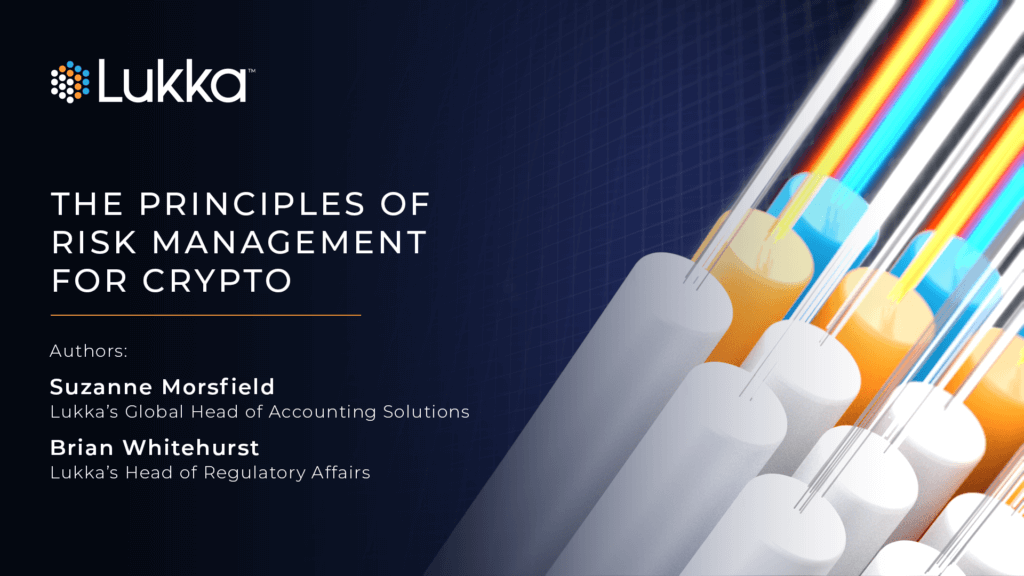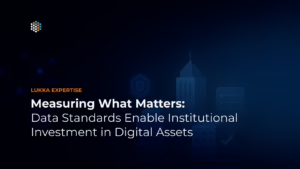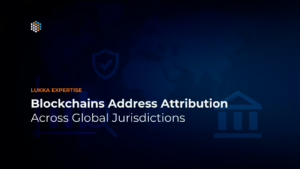Authors:
Suzanne Morsfield, Lukka’s Global Head of Accounting Solutions
Brian Whitehurst, Lukka’s Head of Regulatory Affairs
Background
Recent developments within the crypto industry have captured the attention of crypto market participants and observers. Due to the plunge of the market earlier this summer, highlighted by the collapse of the TerraUSD (UST) stablecoin, and the insolvency of crypto hedge fund Three Arrows Capital, and CeFi platforms Celsius and Voyager, regulators are paying more attention than ever.
These bankruptcies and significant losses shine a light on a key, even basic financial principle–the risk-return relationship. This relationship derives from finance theory and simply put, implies that to take on higher risk, investors typically require a higher return for their investments. To illustrate, numerous entities in the crypto environment offered APYs north of 20%, rates unheard of in traditional finance where yields typically top out at single-digit percentages. And while high yields are nice, investors would be wise to ensure they understand the risk they are taking on, because higher risk does not guarantee sustained higher returns–whether in crypto or in traditional assets.
One of the virtues of crypto and decentralized finance is that the individual has complete control over their finances. No longer are traditional finance middle-men able to reap the majority of the reward. But at what point does that control start to become risk-return negative? As the past few months have shown, too much risk can lead to a collapse of the system because the continuous, long term returns associated with the undisclosed risk becomes untenable over time.
This naturally leads to the observation that a risk management mindset, coupled with risk management methods and tools, are a necessity within the world of crypto finance. Control of your own holdings does not mean subjecting yourself to a system that puts your life’s savings at risk of disappearing one day. While some things are new, losing everything due to poor risk management is not.
Realities dictate that regulators worldwide are going to have a say, and while proportional regulation that doesn’t stifle innovation should be a part of the conversation, it doesn’t need to be the entire story or only solution. Even with all of its advances and improvements over traditional finance, the crypto industry can still learn from traditional finance when it comes to the guardrails that both create and maintain safer innovation and profit-taking.
Can we learn from traditional finance?
Crypto finance has a decentralized approach by design, meaning it operates differently than traditional markets. However, as noted above, it’s still exposed to risk, some of which is the same as traditional finance.
The key is to identify, understand, communicate, and manage all the risks present in crypto transactions. The exact steps to that identification will vary, depending on which side of the transaction one is on. Risk identification and communication are important for those originating crypto finance transactions for investors, lenders, borrowers, and others. Risk understanding and management are crucial for those engaging in the transactions offered to potential investors, borrowers, lenders, etc.
How can Risk Management Improve Crypto Finance?
Traditional finance, while sometimes viewed as the antithesis of crypto, utilizes core principles and tools which the crypto industry can begin to institute to a higher degree in order to protect the market as a whole. Developing the principles below will allow the crypto industry to take a step towards maturity:
- Focus on substance over form
- Many crypto transactions and products call themselves one thing, but when the lawyers and auditors look in, it is shown that the substance is not clear, or does not match the naming or description.
- In simple terms, experts should weigh in before the product goes to market. The form and substance should both match, and be made crystal clear. Classifications that look beyond marketing to the underlying characteristics and components of the products are important.
- Enable and use liquidity analysis and audited financials
- This principle is closely tied to a complete set of audited financial statements and their accompanying notes; with the potential implementation of regulation those involved with the crypto community should aim to produce these traditional financial reports in order to stay ahead of the market.
- If institutional investors involved with crypto conducted thorough pre-investment analysis, and required audited financials, this would require their crypto counterparties to comply with normalized best practices without waiting for regulators to step in.
- Conduct ongoing performance monitoring of the transactions and the counterparty(ies)
- The entity who made the investment or loan should be responsible for conducting its own ongoing, substantive performance monitoring of the crypto product and counterparty, e.g., financial trend, variance analysis, and smart contract audit, where relevant.
- As a routine matter, the contracts should provide for regular statements that mirror those of similar traditional transactions, and for a legally enshrined right to inspect the books.
- Reliable fair value assessments of the crypto held, pledged as collateral, or otherwise used will be a key part of this analysis.
- Clarify collateral, custody, and segregation of assets
- Collateral is a key component of traditional financial arrangements, and applying its processes could be transformative for the maturation of the crypto finance ecosystem i.e., custody should be clear, the pledged assets should not be commingled with corporate assets, and the security interest should be carefully documented and crafted so that the lenders are adequately protected.
- Enhance disclosure and Terms and Conditions (T&Cs)
- The control of one’s finances should not end at the point of transfer to a third-party platform; therefore, how crypto businesses handle customer assets should not be trade secret. By sufficiently disclosing risks and basic practices, providers will not only protect their customers, but also themselves.
- As the crypto industry grows, so too should transparency through disclosures. Clear, predictable, accurate disclosures and terms of service are a must have.
- Promoting mature and easy to understand terms and conditions with fulsome disclosures provides customers a better understanding of the risk they are taking on.
Conclusion
Crypto has ushered in a lot of new features and opportunities in financial services, but it has opened the door to issues in risk management. Institutional quality solutions to these issues are critical for businesses engaging in the crypto ecosystem. Lukka has built best-in-class data and software offerings to aid businesses in managing their risk when they interact with crypto finance.
About Lukka:
Founded in 2014, Lukka serves the most risk mature businesses in the world with institutional data and software solutions. Lukka bridges the gap between the complexities of blockchain data and traditional business needs. Its customers include both Traditional and Crypto Asset Exchanges and Trading desks, CPA & Accounting Firms, Fund and Financial Auditors, Fund Administrators, Miners, Protocols, individuals, and any other businesses interacting with crypto assets. All of Lukka’s products are created with institutional standards, such as AICPA SOC Controls, which focus on accuracy and completeness. Lukka is a global company headquartered in the United States.For information about Lukka, visit https://lukka.tech/



